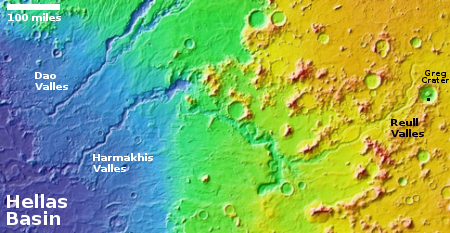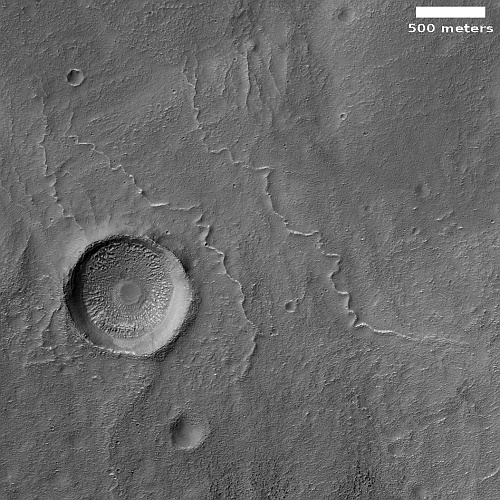Meandering ridges in Greg Crater
Cool image time! The picture to the right, cropped, reduced, and sharpened to post here, was taken on November 29, 2022 by the high resolution camera on Mars Reconnaissance Orbiter (MRO). It shows what the scientists label “curved ridges.”
These might be inverted channels, the beds on which either water or ice flowed, compacting it down so that it became very resistant to erosion, and thus remains when the surrounding terrain was worn away. However, none of them seem to follow any grade. A more likely explanation is that these are ancient moraines, the debris pile pushed ahead of a glacier and then left behind when the glacier goes away.
The location is the reason I favor this explanation.

The black dot inside Greg Crater on the right edge of the overview map to the right marks this picture’s location. The latitude is 39 degrees south, not only well inside the 30-60 degree latitude band where orbital images find many glaciers on Mars, but also in a region to the east of Hellas Basin that scientists have specifically labeled as having numerous glacial features.
Many pictures in this region show similar meandering ridges. See for example this cool image from January 2021 of the north interior rim of of this same crater. See also this picture from November 2022. The second is especially similar to today’s meandering ridges, except that its position paralleling its crater interior wall makes it very clear it is a moraine.
In today’s image, the parallel ridges instead suggest that there were actually two glaciers here once, moving downhill towards each other. The space between the two longest ridges actually appears to be the low point in the southern quadrant of Greg Crater. The two glaciers never quite collided, but instead left opposing moraines only about 1,500 to 2,000 feet apart.
The third ridge to the west, partly destroyed by the impact crater that came later, suggests that there were cycles of glacial growth and decline. Other images suggest that the pattern was that during each growth period the glaciers on Mars grew less, as if there was less water to feed them.
Nonetheless, there are still glaciers in Greg Crater, not only as indicated by the January 2021 image of the glaciers along its north interior rim but by the glacial features seen on the inside of the impact crater on the left of today’s picture.
On Christmas Eve 1968 three Americans became the first humans to visit another world. What they did to celebrate was unexpected and profound, and will be remembered throughout all human history. Genesis: the Story of Apollo 8, Robert Zimmerman's classic history of humanity's first journey to another world, tells that story, and it is now available as both an ebook and an audiobook, both with a foreword by Valerie Anders and a new introduction by Robert Zimmerman.
The print edition can be purchased at Amazon or from any other book seller. If you want an autographed copy the price is $60 for the hardback and $45 for the paperback, plus $8 shipping for each. Go here for purchasing details. The ebook is available everywhere for $5.99 (before discount) at amazon, or direct from my ebook publisher, ebookit. If you buy it from ebookit you don't support the big tech companies and the author gets a bigger cut much sooner.
The audiobook is also available at all these vendors, and is also free with a 30-day trial membership to Audible.
"Not simply about one mission, [Genesis] is also the history of America's quest for the moon... Zimmerman has done a masterful job of tying disparate events together into a solid account of one of America's greatest human triumphs."--San Antonio Express-News
Cool image time! The picture to the right, cropped, reduced, and sharpened to post here, was taken on November 29, 2022 by the high resolution camera on Mars Reconnaissance Orbiter (MRO). It shows what the scientists label “curved ridges.”
These might be inverted channels, the beds on which either water or ice flowed, compacting it down so that it became very resistant to erosion, and thus remains when the surrounding terrain was worn away. However, none of them seem to follow any grade. A more likely explanation is that these are ancient moraines, the debris pile pushed ahead of a glacier and then left behind when the glacier goes away.
The location is the reason I favor this explanation.

The black dot inside Greg Crater on the right edge of the overview map to the right marks this picture’s location. The latitude is 39 degrees south, not only well inside the 30-60 degree latitude band where orbital images find many glaciers on Mars, but also in a region to the east of Hellas Basin that scientists have specifically labeled as having numerous glacial features.
Many pictures in this region show similar meandering ridges. See for example this cool image from January 2021 of the north interior rim of of this same crater. See also this picture from November 2022. The second is especially similar to today’s meandering ridges, except that its position paralleling its crater interior wall makes it very clear it is a moraine.
In today’s image, the parallel ridges instead suggest that there were actually two glaciers here once, moving downhill towards each other. The space between the two longest ridges actually appears to be the low point in the southern quadrant of Greg Crater. The two glaciers never quite collided, but instead left opposing moraines only about 1,500 to 2,000 feet apart.
The third ridge to the west, partly destroyed by the impact crater that came later, suggests that there were cycles of glacial growth and decline. Other images suggest that the pattern was that during each growth period the glaciers on Mars grew less, as if there was less water to feed them.
Nonetheless, there are still glaciers in Greg Crater, not only as indicated by the January 2021 image of the glaciers along its north interior rim but by the glacial features seen on the inside of the impact crater on the left of today’s picture.
On Christmas Eve 1968 three Americans became the first humans to visit another world. What they did to celebrate was unexpected and profound, and will be remembered throughout all human history. Genesis: the Story of Apollo 8, Robert Zimmerman's classic history of humanity's first journey to another world, tells that story, and it is now available as both an ebook and an audiobook, both with a foreword by Valerie Anders and a new introduction by Robert Zimmerman.
The print edition can be purchased at Amazon or from any other book seller. If you want an autographed copy the price is $60 for the hardback and $45 for the paperback, plus $8 shipping for each. Go here for purchasing details. The ebook is available everywhere for $5.99 (before discount) at amazon, or direct from my ebook publisher, ebookit. If you buy it from ebookit you don't support the big tech companies and the author gets a bigger cut much sooner.
The audiobook is also available at all these vendors, and is also free with a 30-day trial membership to Audible.
"Not simply about one mission, [Genesis] is also the history of America's quest for the moon... Zimmerman has done a masterful job of tying disparate events together into a solid account of one of America's greatest human triumphs."--San Antonio Express-News


